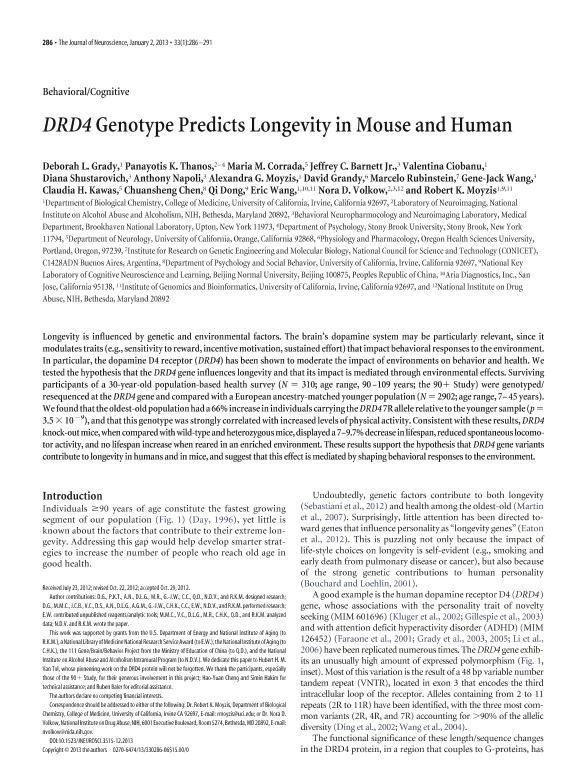Mostrar el registro sencillo del ítem
dc.contributor.author
Grady, Deborah L.
dc.contributor.author
Thanos, Panayotis K.
dc.contributor.author
Corrada, Maria M.
dc.contributor.author
Barnett Jr., Jeffrey C.
dc.contributor.author
Ciobanu, Valentina
dc.contributor.author
Shustarovich, Diana
dc.contributor.author
Napoli, Anthony
dc.contributor.author
Moyzis, Alexandra G.
dc.contributor.author
Grandy, David
dc.contributor.author
Rubinstein, Marcelo

dc.contributor.author
Wang, Gene-Jack
dc.contributor.author
Kawas, Claudia H.
dc.contributor.author
Chen, Chuansheng
dc.contributor.author
Dong, Qi
dc.contributor.author
Wang, Eric
dc.contributor.author
Volkow, Nora D.
dc.contributor.author
Moyzis, Robert K.
dc.date.available
2016-02-03T20:26:02Z
dc.date.issued
2013-01
dc.identifier.citation
Grady, Deborah L.; Thanos, Panayotis K.; Corrada, Maria M.; Barnett Jr., Jeffrey C.; Ciobanu, Valentina; et al.; DRD4 genotype predicts longevity in mouse and human; Society for Neuroscience; Journal of Neuroscience; 33; 1; 1-2013; 286-291
dc.identifier.issn
0270-6474
dc.identifier.uri
http://hdl.handle.net/11336/4011
dc.description.abstract
Longevity is influenced by genetic and environmental factors. The brain's dopamine system may be particularly relevant, since it modulates traits (e.g., sensitivity to reward, incentive motivation, sustained effort) that impact behavioral responses to the environment. In particular, the dopamine D4 receptor (DRD4) has been shown to moderate the impact of environments on behavior and health. We tested the hypothesis that the DRD4 gene influences longevity and that its impact is mediated through environmental effects. Surviving participants of a 30-year-old population-based health survey (N = 310; age range, 90-109 years; the 90+ Study) were genotyped/resequenced at the DRD4 gene and compared with a European ancestry-matched younger population (N = 2902; age range, 7-45 years). We found that the oldest-old population had a 66% increase in individuals carrying the DRD4 7R allele relative to the younger sample (p = 3.5 × 10(-9)), and that this genotype was strongly correlated with increased levels of physical activity. Consistent with these results, DRD4 knock-out mice, when compared with wild-type and heterozygous mice, displayed a 7-9.7% decrease in lifespan, reduced spontaneous locomotor activity, and no lifespan increase when reared in an enriched environment. These results support the hypothesis that DRD4 gene variants contribute to longevity in humans and in mice, and suggest that this effect is mediated by shaping behavioral responses to the environment.
dc.format
application/pdf
dc.language.iso
eng
dc.publisher
Society for Neuroscience

dc.rights
info:eu-repo/semantics/openAccess
dc.rights.uri
https://creativecommons.org/licenses/by/2.5/ar/
dc.subject
Dopamina
dc.subject
Receptor D4
dc.subject
Longevidad
dc.subject.classification
Genética Humana

dc.subject.classification
Medicina Básica

dc.subject.classification
CIENCIAS MÉDICAS Y DE LA SALUD

dc.title
DRD4 genotype predicts longevity in mouse and human
dc.type
info:eu-repo/semantics/article
dc.type
info:ar-repo/semantics/artículo
dc.type
info:eu-repo/semantics/publishedVersion
dc.date.updated
2016-03-30 10:35:44.97925-03
dc.journal.volume
33
dc.journal.number
1
dc.journal.pagination
286-291
dc.journal.pais
Estados Unidos

dc.journal.ciudad
Washington
dc.description.fil
Fil: Grady, Deborah L.. University of California. College of Medicine. Department of Biological Chemistry; Estados Unidos
dc.description.fil
Fil: Thanos, Panayotis K.. National Institute on Alcohol Abuse and Alcoholism. Laboratory of Neuroimaging; Estados Unidos. Brookhaven National Laboratory. Medical Department. Behavioral Neuropharmocology and Neuroimaging Laboratory; Estados Unidos. Stony Brook University. Department of Psychology; Estados Unidos
dc.description.fil
Fil: Corrada, Maria M.. University of California. Department of Neurology; Estados Unidos
dc.description.fil
Fil: Barnett Jr., Jeffrey C.. Brookhaven National Laboratory. Medical Department. Behavioral Neuropharmocology and Neuroimaging Laboratory; Estados Unidos
dc.description.fil
Fil: Ciobanu, Valentina. University of California. College of Medicine. Department of Biological Chemistry; Estados Unidos
dc.description.fil
Fil: Shustarovich, Diana. Brookhaven National Laboratory. Medical Department. Behavioral Neuropharmocology and Neuroimaging Laboratory; Estados Unidos
dc.description.fil
Fil: Napoli, Anthony. Brookhaven National Laboratory. Medical Department. Behavioral Neuropharmocology and Neuroimaging Laboratory; Estados Unidos
dc.description.fil
Fil: Moyzis, Alexandra G.. University of California. College of Medicine. Department of Biological Chemistry; Estados Unidos
dc.description.fil
Fil: Grandy, David. Oregon Health Sciences University. Physiology and Pharmacology; Estados Unidos
dc.description.fil
Fil: Rubinstein, Marcelo. Consejo Nacional de Investigaciones Científicas y Técnicas. Instituto de Investigaciones en Ingeniería Genética y Biología Molecular; Argentina
dc.description.fil
Fil: Wang, Gene-Jack. Brookhaven National Laboratory. Medical Department. Behavioral Neuropharmocology and Neuroimaging Laboratory; Estados Unidos
dc.description.fil
Fil: Kawas, Claudia H.. University of California. Department of Neurology; Estados Unidos
dc.description.fil
Fil: Chen, Chuansheng. University of California. Department of Psychology and Social Behavior; Estados Unidos
dc.description.fil
Fil: Dong, Qi. Beijing Normal University. National Key Laboratory of Cognitive Neuroscience and Learning; China
dc.description.fil
Fil: Wang, Eric. University of California. College of Medicine. Department of Biological Chemistry; Estados Unidos. Aria Diagnostics Inc.; Estados Unidos. University of California. Institute of Genomics and Bioinformatics; Estados Unidos
dc.description.fil
Fil: Volkow, Nora D.. National Institute on Alcohol Abuse and Alcoholism. Laboratory of Neuroimaging; Estados Unidos. Brookhaven National Laboratory. Medical Department. Behavioral Neuropharmocology and Neuroimaging Laboratory; Estados Unidos. National Institute on Drug Abuse; Estados Unidos
dc.description.fil
Fil: Moyzis, Robert K.. University of California. College of Medicine. Department of Biological Chemistry; Estados Unidos. Beijing Normal University. National Key Laboratory of Cognitive Neuroscience and Learning; China. University of California. Institute of Genomics and Bioinformatics; Estados Unidos
dc.journal.title
Journal of Neuroscience

dc.relation.alternativeid
info:eu-repo/semantics/altIdentifier/url/http://www.jneurosci.org/content/33/1/286.long
dc.relation.alternativeid
info:eu-repo/semantics/altIdentifier/url/http://www.ncbi.nlm.nih.gov/pmc/articles/PMC3710129/
dc.relation.alternativeid
info:eu-repo/semantics/altIdentifier/doi/http://dx.doi.org/10.1523%2FJNEUROSCI.3515-12.2013
dc.relation.alternativeid
info:eu-repo/semantics/altIdentifier/issn/0270-6474
Archivos asociados
